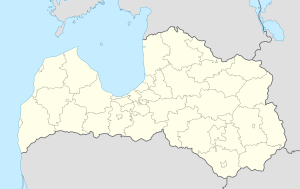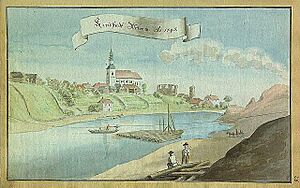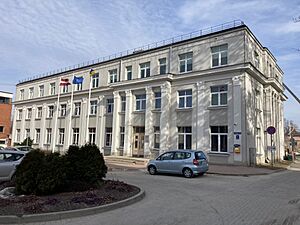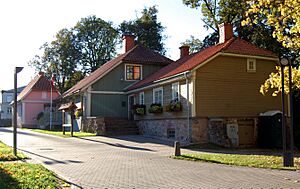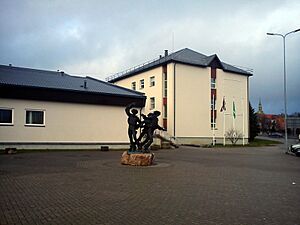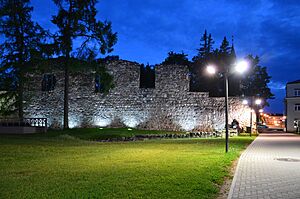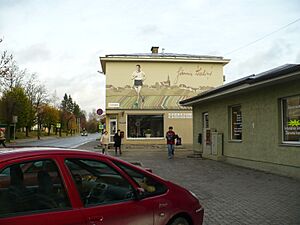Valmiera facts for kids
Quick facts for kids
Valmiera
Wolmar
|
|||||
|---|---|---|---|---|---|
|
State city
|
|||||
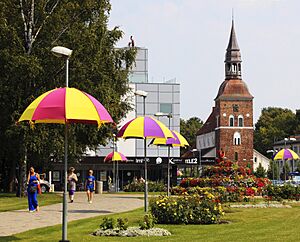
City centre with St. Simon's Church behind
|
|||||
|
|||||
| Anthem: Stāv pāri visam Valmiera | |||||
| Country | |||||
| Municipality | Valmiera | ||||
| Town rights | 1323 | ||||
| Area | |||||
| • Total | Lua error in Module:Wd at line 1,575: attempt to index field 'wikibase' (a nil value). km2 (Formatting error: invalid input when rounding sq mi) | ||||
| • Water | Expression error: Unexpected < operator. km2 (Formatting error: invalid input when rounding sq mi) | ||||
| Population
(2024)
|
|||||
| • Total | 22,376 | ||||
| Demonym(s) | Valmierieši | ||||
| GDP | |||||
| • State city | 476,254,000 Euro (2021) | ||||
| • Per capita | 20,846 Euro (2021) | ||||
| Time zone | UTC+2 (EET) | ||||
| • Summer (DST) | UTC+3 (EEST) | ||||
| Calling code | +371 642 | ||||
| Number of city council members | 13 | ||||
| Website | http://www.valmiera.lv/ | ||||
Valmiera is the biggest city in the Vidzeme region of Latvia. It covers an area of about 19.35 square kilometers. In 2024, its population was around 22,376 people.
Valmiera is a special "state city" and the main center for the Valmiera Municipality. It is one of Latvia's oldest cities and used to be part of the Hanseatic League, a powerful group of trading cities. Many people in Valmiera are ethnic Latvians, more than in other state cities.
The city is located at a key point where several important roads meet. It's about 107 kilometers northeast of Riga, Latvia's capital. The border with Estonia is only 50 kilometers to the south. Valmiera is built on both sides of the Gauja River.
Contents
Understanding Valmiera's Name
The name Valmiera likely comes from an old German name, Waldemar, or a Slavic name, Vladimir. One idea is that it was named after Vladimir Mstislavich, a prince who became a helper to Albert of Riga in 1212. He briefly managed some areas nearby.
Another idea is that the city was named after Valdemar II, the King of Denmark. He joined forces with the Livonian Brothers of the Sword during the Livonian Crusade. Later, in the 13th century, the Livonian Order built a castle here. They called it Wolmar in German.
During the Livonian War, the city was known as Volodimirec in Russian. When it was part of the Russian Empire, it was called Wolmar.
Valmiera's Long History
Valmiera and the areas around it have been lived in for a very long time. Scientists have found signs that people lived here as far back as 9,000 years ago.
In 1224, after the area of Tālava was divided, the trade routes along the Gauja River became property of the Livonian Brothers of the Sword. They built a castle, which is now known as Valmiera Castle. After a battle in 1236, the castle and nearby lands became part of the new Livonian Order.
Valmiera was first called a town in a record from 1323. The town was probably started even earlier, maybe 40 years before. This was when the leader of the Livonian Order, Wilken von Endorp, built a castle and a Catholic church by the Gauja River.
Valmiera was a member of the Hanseatic League from the 1300s to the 1500s. Being part of this trading group brought a lot of business and people to the town. During these centuries, many important regional meetings were held in Valmiera.
After the Livonian War in 1583, Valmiera was badly damaged. It became part of the Duchy of Livonia. After another war between Poland and Sweden in 1622, Axel Oxenstierna from Sweden took charge of Valmiera.
During the Great Northern War, Valmiera was destroyed and burned down again in 1702. A terrible plague also hit the city. For the first half of the 1700s, Valmiera was not doing well.
In 1738, M.E. von Hallart opened the first school for the Moravian Church in Valmiera. This group was very important in the history of Vidzeme.
In 1785, Valmiera became the center of a district. The town grew quickly in the 1800s. First, a bridge was built over the Gauja River in 1865. Then, a railway line connecting Riga and St. Petersburg came through the town in 1899. This helped Valmiera grow even more. Many new factories were built, and new areas developed on both sides of the Gauja River.
Between 1911 and 1912, a smaller railway line was built, connecting Valmiera to other towns. This made Valmiera a major transport hub. In 1906, local elections were held. Valmiera was one of the few towns where Latvians won most of the seats. As a result, a local doctor named Georgs Apinis became mayor.
In the early 1900s, Valmiera also became a center for culture and learning. Many schools opened, including a teachers' college and schools for women and merchants.
During World War II, German troops took over Valmiera on July 4, 1941. In October 1941, many people of Jewish heritage from Valmiera and nearby areas were tragically killed in local forests. The city was taken back by the Red Army on September 24, 1944. During the war, most buildings in the center of Valmiera were destroyed.
The Liepas Air Base, used during the Cold War, was located nearby. The open-source mapping program QGIS even named one of its versions after Valmiera.
City Development and Economy
Valmiera's city government has worked on many projects to make life better for its residents.
- Recent Projects
- Rebuilding Valmiera Pārgauja State Gymnasium.
- Renovating Valmiera Viestura Secondary School.
- Building homes for different social groups.
- Creating a walking path and viewing area.
- Building the Māris Štrombergs BMX track.
- Constructing the Valmiera Western Industrial highway.
- Opening a co-creation workshop called “DARE”.
- Renovating Jānis Daliņš Stadium and building an indoor athletics hall.
- Developing Valmiera Old Town – Ziloņu Street.
- Introducing hybrid buses in the city.
- Building a woodchip boiler house for heating.
- Current Projects
- Building a dormitory for students.
- Developing Valmiera Old Town – Valmiera Palace cultural center.
- Creating new recreational and playground areas.
- Adding two electric buses to the city's transport.
- Building the Valmiera Southern Industrial highway.
- Supporting career development programs.
- Renovating the Valmiera Drama Theater.
Valmiera is an important place for industry. The main types of businesses in Valmiera are food industry, making fibreglass, metalworking, wood processing, and making furniture.
TOP 5 companies by sales (2018):
- “Valmieras Glass Group” JSC
- Cooperative “VAKS”
- "Valmieras piens" JSC
- “Dizozols”, Ltd
- Cooperative society of agricultural service dairy farmers “PIENA LOĢISTIKA”
Education in Valmiera
Valmiera offers a complete education system, from preschool to university and lifelong learning.
The city provides many types of schools:
- 8 Kindergartens
- 2 Primary Schools
- 4 Secondary Schools, including special education for children with disabilities
- 2 State Gymnasiums
- Valmiera Music School
- Valmiera Sports School
- Valmiera Youth Centre "Vinda"
- Valmiera School of Design and Art
- Valmiera Vocational Education and Training School
- Vidzeme University of Applied Sciences
- Lifelong learning programs
In the 2019-2020 school year, 1625 children attended preschools. Also, 4084 students were in general education schools.
The local government invests a lot of money in improving school buildings and facilities. More than half of Valmiera's yearly budget goes towards education.
In 2016, Valmiera joined the UNESCO Global Network of Learning Cities. This network helps cities find solutions to modern challenges like globalization and population changes.
Culture and Arts
Valmiera has many places for culture and art:
- Valmiera Drama Theatre
- Valmiera Culture Centre
- Cinema "3D CINEMA" (kino "Gaisma")
- Concert hall "Valmiera"
- Valmiera Integrated Library
- Valmiera Museum
- Art „Gallery Laipa”
- Gallery „Leduspagrabs”
The city also hosts many festivals and events each year:
- International Winter Music Festival
- International competition for young pianists
- Valmiera Summer Theatre Festival
- Valmiera City Festival
- Simjūds’ Fair (a traditional fair)
- Summer concerts by the Valmiera Music School
- Cinema festival "Kino Pedālis"
- Art month of Valmiera
- And many more!
Sports and Active Lifestyle

Sports and being active have always been very important in Valmiera. More than 40 sports groups operate here, covering over 30 different sports. The Valmiera Children's Sports School is the fourth largest in Latvia, with over 1,200 students.
In the 1932 Summer Olympics, Jānis Daliņš won a silver medal. This was Latvia's first ever Olympic medal! In his honor, Valmiera Stadium was named after him in 1938. Many Olympic athletes come from Valmiera. These include BMX riders like Ivo Lakučs, Edžus Treimanis, Rihards Veide, and two-time Olympic champion Māris Štrombergs.
Race walkers like Jolanta Dukure, Arnis Rumbenieks, and Aigars Fadējevs also started their sports careers in Valmiera. The same is true for bobsleigh racers Oskars Ķibermanis and Oskars Melbārdis.
Biggest sports teams in Valmiera:
- Valmiera Basketball Club – won the Latvian Basketball League in 2015/2016.
- Valmiera Floorball Club – were runners-up in the Floorball Latvia League in 2017/2018.
- Valmiera Football Club – won the Latvian Higher Football League in 2022.
- Valmiera Glass ViA – plays in the Latvian-Estonian Basketball League.
Valmiera has great sports facilities. These include Jānis Daliņš’ Stadium, Māris Štrombergs’ BMX track, the Vidzeme Olympic Centre, "Krāces" rowing base, Valmiera Swimming Pool, and outdoor running and walking tracks.
Biggest annual sports events in the city:
- The State President's Athletics Competition
- Valmiera Marathon
- MTB Marathon (mountain bike race)
- “Rīga-Valmiera” Running and Walking Race
- Latvian Open Floorball Tournament
- European Championship Qualification Games in Men's Handball
Major sports events held in Valmiera in the past:
- 2011 FIBA Basketball World Championship U-19 Junior Sub-Group Games
- 2014 Davis Cup Group Ties in Tennis
- 2018 IFF World Championship Men's Floorball Qualification Tournament
- BMX European Championships 2019
Twin towns – sister cities
Valmiera is connected with these cities around the world:
 Solna, Sweden (1991)
Solna, Sweden (1991) Viljandi, Estonia (1992)
Viljandi, Estonia (1992) Gütersloh (district), Germany (1994)
Gütersloh (district), Germany (1994) Høje-Taastrup, Denmark (1995)
Høje-Taastrup, Denmark (1995) Zduńska Wola, Poland (2001)
Zduńska Wola, Poland (2001) Pskov, Russia (2002)
Pskov, Russia (2002) Barysaw, Belarus (2010)
Barysaw, Belarus (2010) Halle, Germany (2011)
Halle, Germany (2011) Siyazan, Azerbaijan (2014)
Siyazan, Azerbaijan (2014) Vallefoglia, Italy (2016)
Vallefoglia, Italy (2016) Cherkasy, Ukraine (2022)
Cherkasy, Ukraine (2022)
Gallery
Notable People from Valmiera
- Jāzeps Vītols (1863–1948), a famous composer
- Velta Ruke-Dravina (1917–2003), a linguist and professor
- Maija Einfelde (1939–), a composer
- Andris Piebalgs (1957–), a politician and diplomat
- Arturs Maskats (1957–), a composer
- Ģirts Ķesteris (1964–), an actor
- Ainārs Ķiksis (1972–), a cyclist
- Ivo Lakučs (1979–), a cyclist
- Mārcis Rullis (1979–), a bobsledder
- Jolanta Dukure (1979–), an athlete
- Māris Štrombergs (1987–), a BMX racer
- Edžus Treimanis (1988–), a BMW racer
- Arnis Rumbenieks (1988–), an athlete
- Oskars Melbārdis (1988–), a bobsledder
- Dairis Bertāns (1989–), a basketball player
- Dāvis Bertāns (1992–), a basketball player
- Rolands Šmits (1995–), a basketball player
- Agate Caune (2004–), an athlete
See also
 In Spanish: Valmiera para niños
In Spanish: Valmiera para niños




